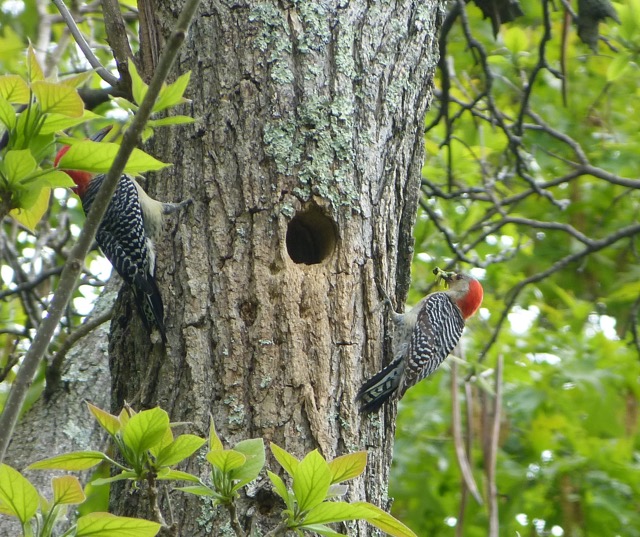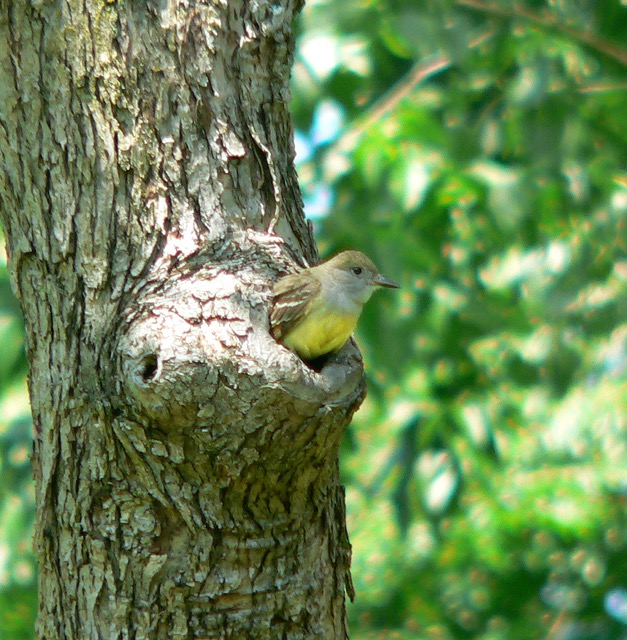
The Arboretum’s celebrity eastern screech-owl has returned to her winter roost in Robinia pseudoacacia (black locust) Accession #23173-C for a fifth consecutive season. For those who spot her sunbathing on a late winter’s morning (like Arboretum Docent and birder Bob Mayer, whose photographs accompany this post), her face is the picture of contentment. And with such a perfect home, why shouldn’t she be happy? From her camouflaged south-facing roost, she has daytime warmth from the winter sun, nightly access to water at the ponds, and prey in the surrounding woods. However, this cute little owl represents only one of many cavity dwelling birds at the Arboretum, all of which compete for a limited amount of available real estate.
To put this in terms Bostonians may relate to, competition for roosts and nests is high because of a lack of existing options and not enough space for new construction. For birds, this translates as not enough primary cavity dwelling species and a lack of suitable snags (standing dead trees). Primary cavity dwelling birds drill, chip, and scrape holes into trees, most often into sections already dead or rotting. At the Arboretum, the most prominent birds in this group are downy woodpeckers, red bellied woodpeckers, and northern flickers. These birds tend to excavate multiple roosts each winter (hideouts for the harsh months to come) and then several more nesting sites each spring. Since they rarely reuse old sites, the result is vacant housing for other species to inherit.

The new tenants are secondary cavity dwellers and include small birds such as eastern blue birds, tufted titmice, and tree swallows, as well as birds of prey like eastern screech-owls, barred owls, and American kestrels. Squirrels add to the pressure by clamoring for any accessible spots. Although secondary species do not excavate tree cavities on their own, they often enlarge existing sites to suit their needs.
Natural cavities are another important resource for birds and can form for many reasons. For example, trees respond to broken branches by attempting to grow new tissue around the affected areas, a process known as compartmentalization. The goal is to create a barrier and prevent pest and diseases from reaching the exposed, healthy wood. You can see this process on older accessions within our collection, where branch collar tissue has completely grown over past pruning cuts. However, since open wounds are susceptible to moisture, infection, and rot, many trees are unable to heal fast enough and cavities form as a result. Our little screech-owl’s hideaway appears to be on one such spot.

A bird housing market that is dependent on rotting trees and available construction workers is an issue at the Arnold, where the goal of the horticultural staff is to keep accessioned plants healthy. Horticulturists and arborists remove dead, damaged, and diseased branches in order to speed along the process of compartmentalization. They also cast wary eyes on cavities, which can indicate serious structural problems as well as disease entryways. Snags in the collection are removed completely. As a result, our accessioned collection is not be the best place for cavity dwellers or for birds that feed upon insect larvae found in rotting wood.
However, the snags and rotting logs in our natural areas, such as the North Woods along Meadow Road, the Central Woodlands along Conifer Path, Peters Hill Woodland, and the woods on Hemlock Hill offer more opportunity for roosting, nesting, and finding food. Paradoxically, the relative wilderness of these woods could be another reason why our little screech-owl seems to like her urban roost above Meadow Road so much. Her avian predators, including barred and great horned owls, seem to prefer the natural areas and are periodically seen or heard within them. It is no coincidence that eastern screech-owls are common in fragmented, suburban, and urban locales where their predators are less numerous.
Interested in learning how to identify Boston’s many bird species? Want to learn more about the trees that birds depend on? Arboretum Docent Bob Mayer and I will be leading a winter birding tour at 9:00am on Sunday, January 14 focusing on birds and trees at the Arboretum. Starting at the Hunnewell Building, we will take a wander through the landscape, look for birds, and discuss the plants they rely on for survival.